This low FODMAP Polenta (pronounced puh-len-tuh) is an easy and delicious low FODMAP side dish that pairs beautifully with main dishes like braised short ribs, ratatouille, pot roast, Bolognese, and more. Made with just cornmeal, ghee or butter, parmesan cheese and simple seasonings, this polenta recipe is low FODMAP, gluten-free (although if you require 100% gluten-free, check the packaging to ensure your cornmeal is ground in a gluten-free facility), and vegetarian (as long as you eat dairy). As it is a grain, cornmeal / polenta is not Paleo or Whole30 compliant.
Jump to:
- Is Cornmeal Low FODMAP?
- Is this really a side dish? It looks like breakfast!
- What type of cornmeal should I use?
- Can I cook this in the Instant Pot?
- Necessary Equipment
- Low FODMAP Polenta: Ingredients & Success Tips
- Serving & Storing Low FODMAP Polenta
- What can I eat this low FODMAP polenta with?
- Low FODMAP Polenta (Gluten-Free)
- Related Recipes
Is Cornmeal Low FODMAP?
Cornmeal is low FODMAP in certain quantities. According to Monash University's Low FODMAP Diet App, cooked polenta (cornmeal) is low FODMAP in servings of up to 1 cup or 255 grams per serving. When it comes to low FODMAP grains, that is a lot of polenta to work with.
Sweet corn, on the other hand, is higher in FODMAPs. A low FODMAP serving of fresh sweet corn is only up to ½ of a cob or 38 grams. Simply put, cornmeal is lower in FODMAPs due to the types of corn it's made from being lower in FODMAPs and higher in starch.
Is this really a side dish? It looks like breakfast!
If you're new to polenta, it may come across oddly as a side dish at first as it looks like porridge. My husband, Jeff, and I both had this initial reaction. Cornmeal can be eaten for breakfast, but this low FODMAP polenta recipe is inspired by the preparation common to Northern Italy, which is served alongside dishes that you'd typically serve with pasta, such as Bolognese. I have three recipes that taste dynamite when paired with polenta: Low FODMAP Instant Pot Ratatouille, which is a French vegetable stew; Low FODMAP Stracotto (Instant Pot / Slow Cooker), which is Italian pot roast; and low FODMAP Bolognese (Instant Pot / Slow Cooker). Subscribe to be notified when more new recipes that pair well with this low FODMAP polenta hit the blog!
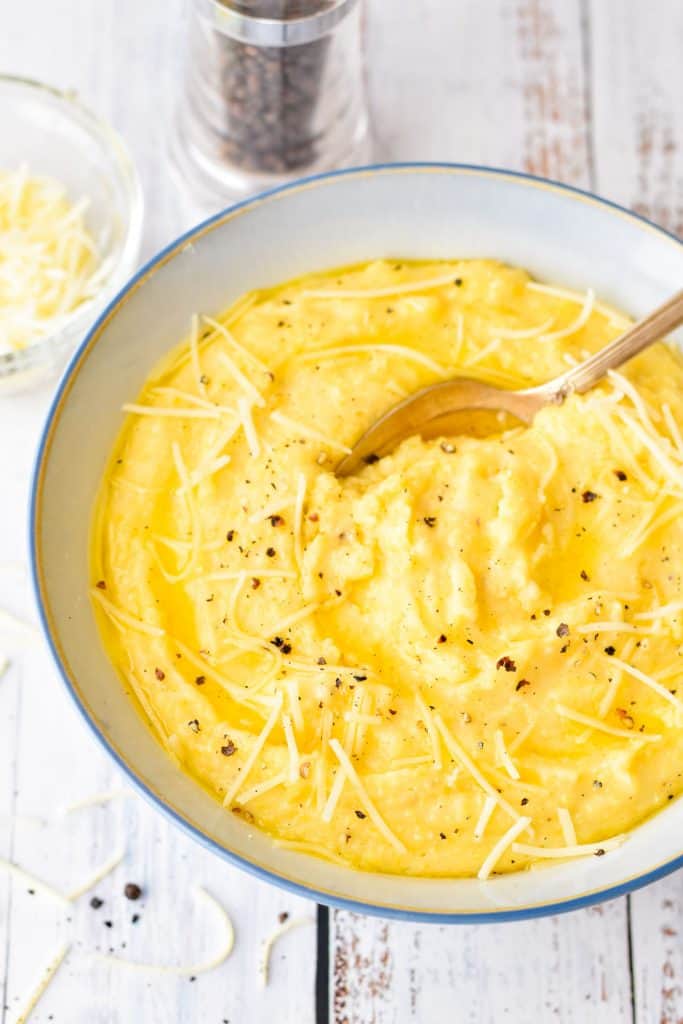
What type of cornmeal should I use?
There are a variety of different types of cornmeal you can buy: ground, instant or quick cooking, and pre-cooked. We want coarsely-ground cornmeal. Instant or quick cooking cook too quickly to achieve the ideal texture for polenta, in my opinion. Sometimes polenta comes in a tube - this is the pre-cooked version, which we will not be using for this recipe. This recipe calls for uncooked, dry, ground polenta / cornmeal. I use Bob's Red Mill Organic Corn Grits also known as Polenta, but this particular one is not made in a gluten-free facility. If you require 100% gluten-free, be sure to get the gluten-free version. I bought mine on Amazon, but you might be able to find it at some health food stores or some gluten-free aisles at mainstream grocery stores.
Can I cook this in the Instant Pot?
It may shock and disappoint some people that this is not an Instant Pot recipe. While I believe it might be possible to cook polenta in the Instant Pot, it's one of those things that there is too much risk for error for me to confidently put out a recipe that I believe will work for most people. Due to the large amount of starch in cornmeal, there is high risk for the dreaded burn error (dun dun DUN!). This risk varies by the brand of cornmeal that you're using. So, this is a stovetop polenta recipe. I cannot stand getting burn errors with the Instant Pot, nor do I care to lead anyone into this black hole of doom that is the burn error.
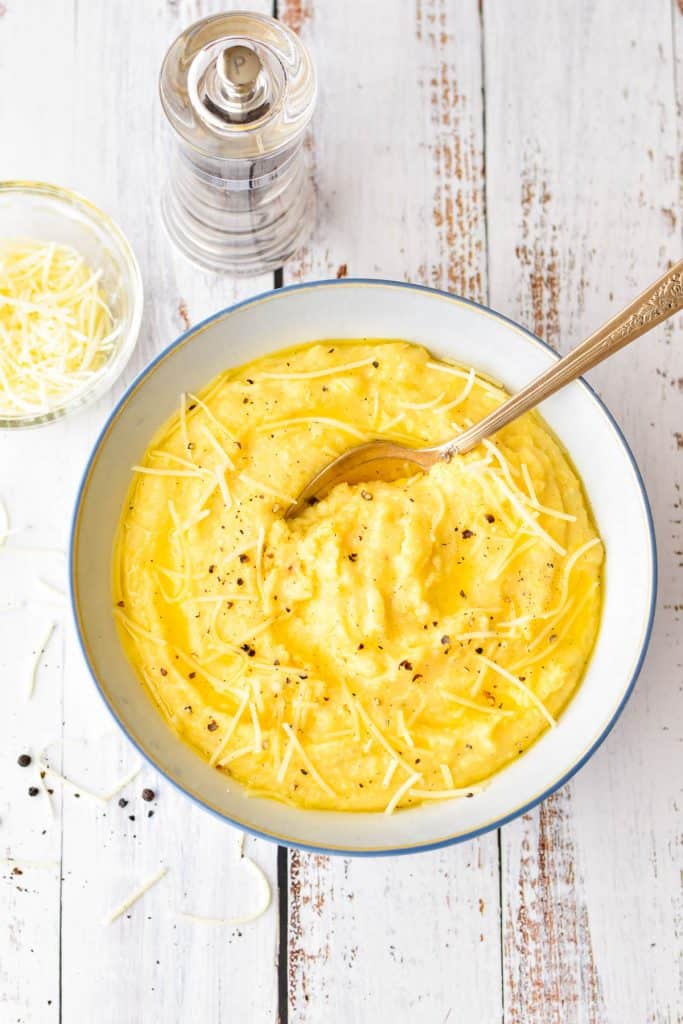
Necessary Equipment
Nothing fancy here! The equipment I use to make this low FODMAP polenta recipe includes:
- Stovetop
- Large saucepan (mine is 3-quarts)
- Whisk (the longer, the better)
- Measuring cups and spoons
- Serving spoon
Low FODMAP Polenta: Ingredients & Success Tips
Water or Broth & Cornmeal
To start this low FODMAP polenta recipe, I place a medium saucepan on high heat. Then, I add 4 cups of water or low FODMAP chicken bone broth (homemade or store-bought). Once the water (or broth) starts boiling, I slowly add the cornmeal, salt and pepper and whisk to combine. See my notes above for more information on the type of cornmeal to use, FODMAPs, etc. I reduce the heat to low, which is "Min" on my stove - the absolute lowest setting. Then, I allow the polenta to cook, whisking frequently, for about 20 minutes, or until the polenta starts to pull away from the sides of the pan when stirred.
While the polenta is cooking, use caution as it likes to bubble up and splat you. Using a longer whisk is ideal here as creates more distance between you and the potential splatter.
Also, to prevent clumping, frequent whisking is key. Also, you might want to use a spoon instead of a whisk when the polenta thickens. I would advise you to continue using your whisk as it better prevents the polenta from clumping.
Parmesan & Ghee or Butter
This low FODMAP polenta recipe is not dairy-free. The low FODMAP diet is not a dairy-free diet, but some people are lactose intolerant and therefore restrict their consumption of the FODMAP lactose.
Once the polenta is cooked, I remove the pan from heat. Then, I add the parmesan cheese and ghee or butter and whisk to combine. According to Monash University's Low FODMAP Diet App, parmesan cheese only contains trace amounts of FODMAPs.
I use ghee (a.k.a. clarified butter) as I cook with it all the time. If you prefer regular 'ole butta, then feel free to use it. Butter doesn't contain FODMAPs; however, butter and cheese are both high in fat, which can be an additional symptom trigger for some people. Before making this recipe, check with your doctor or dietician with concerns of how your body might react.

Serving & Storing Low FODMAP Polenta
Polenta is best just after its cooked as it tends to firm up and not be as creamy once reheated. Reheated, firmer polenta is still delicious, and I don't mind eating it when it's firm. Store in an air-tight container in the refrigerator for up to 4 days.
What can I eat this low FODMAP polenta with?
This low FODMAP polenta would go wonderfully with the following low FODMAP main dishes:
- Low FODMAP Instant Pot Chicken Cacciatore
- With the meatballs and sauce in Low FODMAP Instant Pot Spaghetti and Meatballs
- With the pot roast and drippings in Low FODMAP Instant Pot Beef Pot Roast
- Low FODMAP Instant Pot Ratatouille
- Low FODMAP Instant Pot / Slow Cooker Stracotto: Italian Pot Roast
- Low FODMAP Instant Pot / Slow Cooker Bolognese
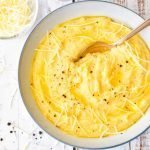
Low FODMAP Polenta (Gluten-Free)
- Total Time: 25 minutes
- Yield: 8 servings 1x
- Diet: Gluten Free
Description
This Low FODMAP Polenta is a simple yet delectable Italian side dish that pairs beautifully with a variety of main dishes like braised short ribs, ratatouille (French vegetable stew), stracotto (Italian pot roast), and more. Gluten-free and vegetarian (as long as you eat dairy).
Ingredients
- 4 cups low FODMAP chicken bone broth (homemade or store-bought), or water
- 1 cup coarsely-ground cornmeal / polenta (not instant or quick cook)*
- 1 teaspoon salt
- ¼ teaspoon black pepper, freshly-ground
- ¾ cup fresh parmesan, finely shredded*
- 3 tablespoons ghee or butter*
Instructions
- Place a large saucepan (mine is 3-quarts) on high heat on the stove top and add broth or water.
- Once the liquid is boiling, slowly add polenta, salt and pepper and whisk to combine.
- Reduce heat to low (“Min” on my stove) and cook, whisking frequently to prevent clumping, until the polenta is thick and creamy and pulls away from the edges of the pan, about 15-20 minutes. A longer whisk is ideal as the polenta is prone to bubble up and splatter. Watch your arms!
- Remove saucepan from heat. Add shredded parmesan and ghee or butter and whisk until combined. Serve immediately. Leftovers will firm up and won’t be as creamy upon reheating but still delicious.
- Serve with my Low FODMAP Instant Pot Ratatouille, my Low FODMAP Instant Pot / Slow Cooker Stracotto (Italian Pot Roast), or my Low FODMAP Instant Pot / Slow Cooker Bolognese.
Equipment

Bob's Red Mill Gluten-Free Corn Grits / Polenta
Buy Now →
Bob's Red Mill Organic Corn Grits / Polenta
Buy Now → Buy Now →
Buy Now → Notes
- Cornmeal / polenta: I use Bob's Red Mill Organic Corn Grits / Polenta, but this particular one is not made in a gluten-free facility. If you require 100% gluten-free, be sure to get the gluten-free version.
- Parmesan cheese: according to Monash University's Low FODMAP Diet App, parmesan cheese only contains trace amounts of FODMAPs.
- Butter: does not contain FODMAPs; however, it and cheese are both high in fat. According to Monash University's Low FODMAP Diet App, “fat affects gut motility, and when consumed in excess, can be an additional symptom trigger.”
- Servings: This recipe makes six ⅔ cup servings or eight ½ cup servings or a total of about 4 cups.
- Prep Time: 5 minutes
- Cook Time: 20 minutes
- Category: Side Dish
- Method: Stovetop
- Cuisine: Italian


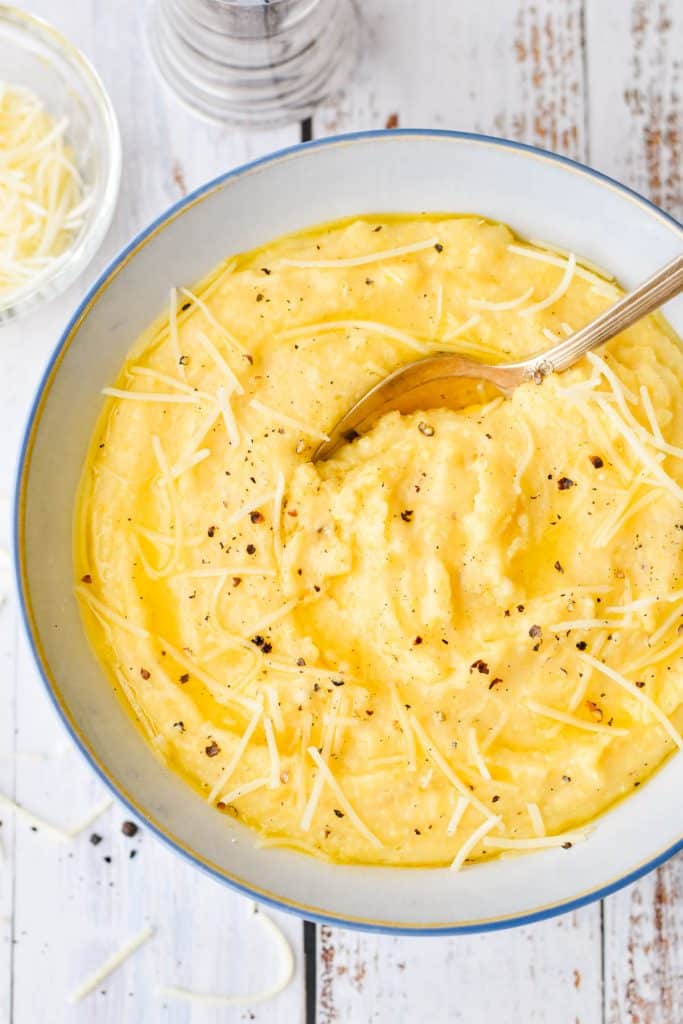
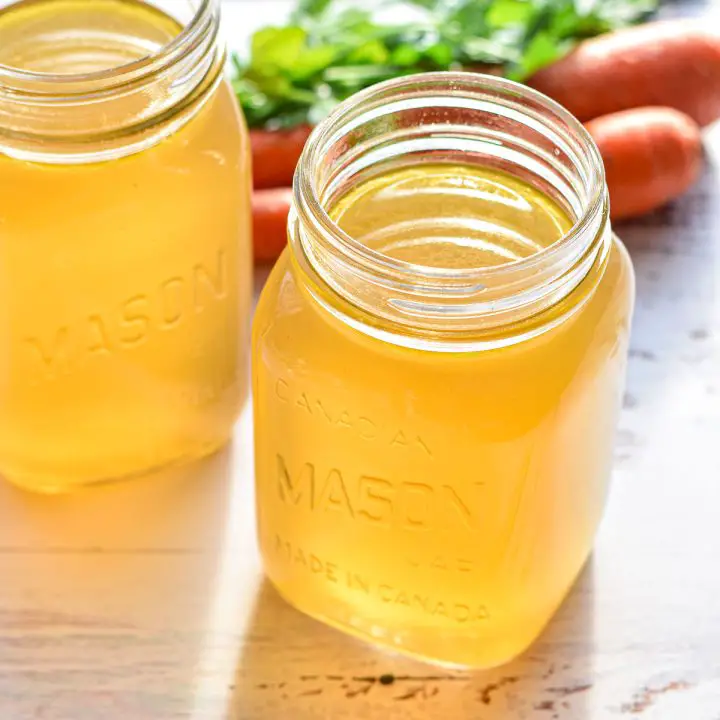
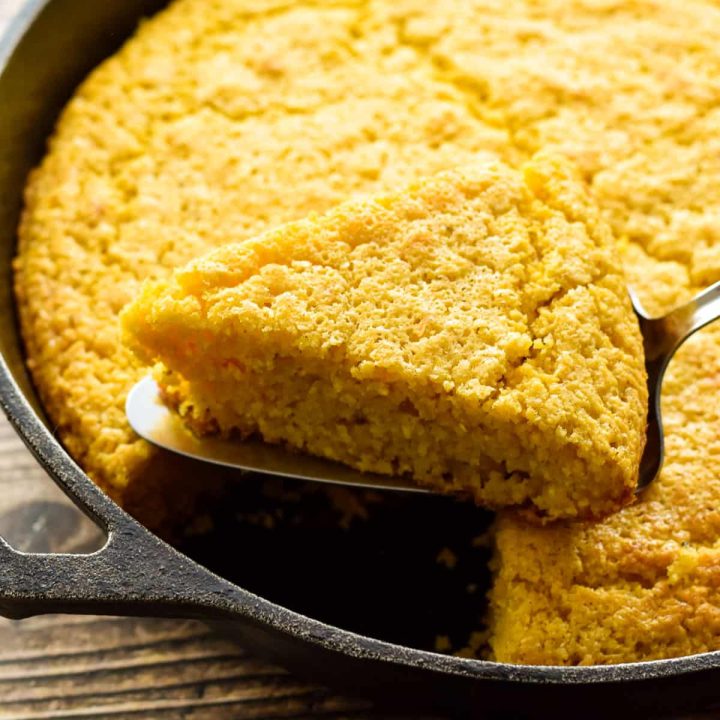

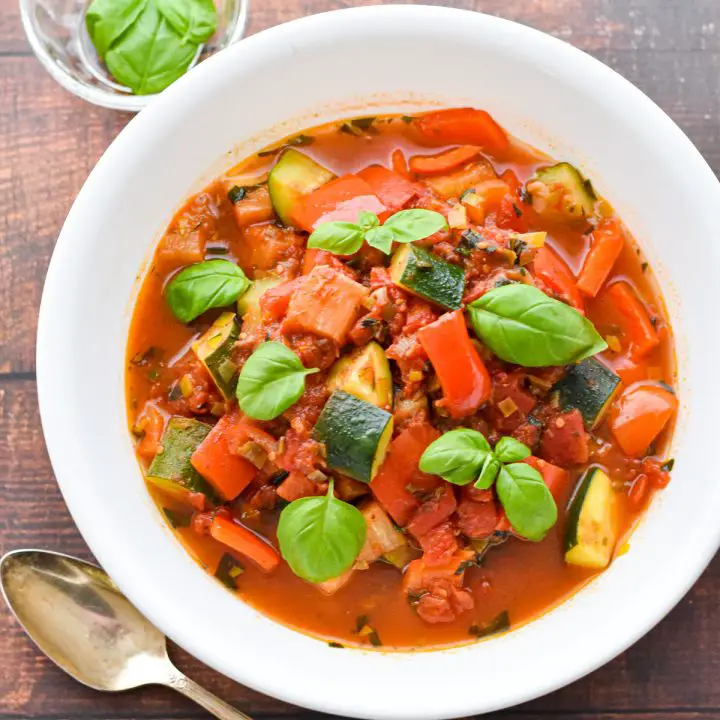

Leave a Reply